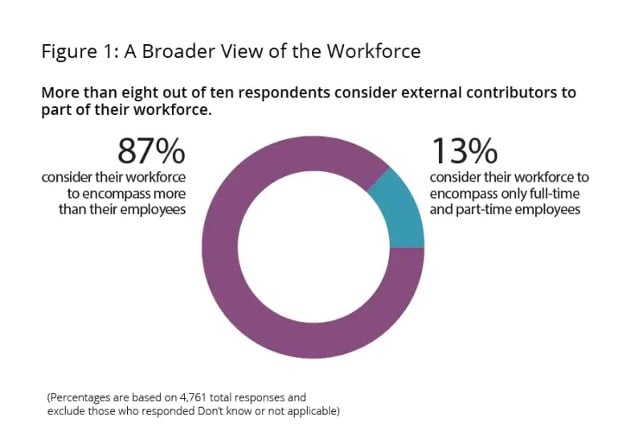Listen to this blog:

According to a recent Deloitte survey, 87% of managers surveyed consider their workforce to encompass more than just full-time and part-time employees. They believe that their workforce is comprised of contractors, suppliers, service providers and even software bots. This represents a big shift in the traditional workforce ecosystem. What would a broader view of the traditional workforce mean?

Even given that belief, the same managers admit that their company’s policies regarding acquisition, retention, compensation, and perks are all focused on full and part-time employees. If company leaders are going to effectively manage both an internal and external workforce, a shift in management practices is going to be necessary, in all these areas:
- A re-defined workforce: identify all the talent and positions necessary to do the work.
- Talent Acquisition: Human Resources would focus on the work required (rather than on traditional company roles) and coordinate with Procurement or other areas to identify either internal or external sources of talent necessary to complete the work.
- Performance Management: The external workforce would have goals and performance metrics similar to those of company employees. Defined reward, recognition, and performance improvement programs can be adapted to include appropriate external partners. External workforce goals and metrics can be aligned with work outcomes and company goals.
- Compensation and Rewards: Supplier contracts can be based on contributions, goals, and performance achievement.
- Learning and Development: Traditionally, managers train individual employees for a specific job function. With this new model, the focus would be on filling the required job function with the appropriate skillset (internally or externally). It will still be advantageous to train employees for anticipated future needs, but the new model broadens the pool of talent to provide the skills needed.
- Career paths: Hierarchical paths can be replaced with a marketplace including internal and external workers driven by their interests and skillsets. Project-based work can offer additional opportunities to both internal and external workers.
- Organizational Design: The organizational structure would look quite different as it shifts from silos to a structure focused on teams based on the work required. The organizational chart would include both internal as well as external work partners.
A shift from the traditional linear career path to a workforce ecosystem approach can help companies to achieve the more diverse and inclusive workforce that is proven to deliver greater results. As companies rely on more non-employees to get the work done, a workplace ecosystem approach facilitates work that is becoming increasingly project-based.
Contact us today to discuss how to include your broader workforce into your reward, recognition, and performance improvement programs!


